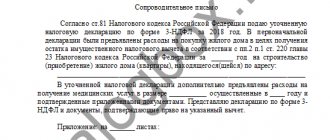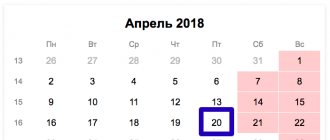The tax burden for VAT is an information indicator to which tax authorities pay the closest attention. After all, if it is below the stated standards, then this is a reason for a desk or on-site inspection. It is determined by calculation. The procedure for the actions of inspectors is regulated by a letter from the Federal Tax Service dated July 17, 2013. No. AS-4-2/ [email protected] “On the work of commissions on the legalization of the tax base.” In this article we will look at how the VAT tax burden is calculated based on two practical examples.
The essence of the problem
Checking the Federal Tax Service is a real headache for any economic entity.
Especially if the inspection is on-site, and the topic of control activities is value added tax. It is worth noting that the inspectorate initiates unscheduled inspections quite rarely. This requires compelling reasons, for example, significant violations of the Tax Code of the Russian Federation and deliberate tax evasion. In other cases, on-site inspections of the Federal Tax Service are carried out as usual, according to the approved list of taxpayers. Who gets on these “black” lists and in what cases?
Officials have provided a special calculation indicator - the tax burden for VAT in 2021. This is the value that determines the ratio of fiscal obligations to the volume of applied deductions. So, if a company claims substantial VAT deductions, thereby significantly underestimating fiscal payments to the budget, this will arouse great interest from tax authorities. That is, inspectors will suspect that the company is playing unfairly. Consequently, it is precisely such a subject that will be checked personally during an on-site inspection.
This calculated indicator is called the “VAT tax burden”; the calculation formula is presented below.
Run check
In the story told, the tax authorities themselves wrote in their request what they check when checking declarations. This means that after preparing the reports, the accountant must carefully double-check the volumes of revenue indicated in the declarations for previous periods. What should the new accounting specialist do? He needed to start from the true amount of income, adjusting the updated reporting to it. However, just counting is not enough - you need to understand how the calculation of the tax burden works, which the foolish accountant could not determine. After all, distortions in volumes are not just a spelling error, it is a miscalculation by an illiterate accountant, which the auditors saw.
Let's look at a simple example and analyze why the tax burden depends. So the task.
Example
Romashka LLC’s revenue at the end of the billing period amounted to 2,000,000 rubles.
a) VAT in the amount of 2,000,000 * 18% = 360,000 rubles;
b) salary + taxes from payroll = 1,000,000 rubles;
c) the cost of goods, works and services received from counterparties who pay VAT = 500,000 rubles + VAT (18%) in the amount of 90,000 rubles;
d) The cost of goods, work and services received from counterparties who do not pay VAT = 200,000 rubles.
How much VAT and income tax will Romashka LLC pay?
VAT is calculated as: 360,000 – 90,000 =270,000 rubles.
Income tax: 2,000,000 – 1,000,000 – 500,000 – 200,000 = 60,000 rubles.
Total the company will pay: 270,000 + 90,000 = 360,000 rubles in taxes.
This example is quite simple, but its essence is that a manager can, by asking three simple questions to his chief accountant, independently calculate the tax burden, and then check with an accounting specialist who will bring VAT and income tax returns to sign.
How to count
So, in order to determine what fiscal burden on value added tax a particular economic entity bears, it is necessary to carry out a simple arithmetic calculation. Divide the amount of VAT deductions for 12 months by the amount of accrued tax for the same period, and then convert the result into a percentage. That is, multiply by 100%.
Tax burden for VAT - calculation formula:
Please note that the reporting period for value added tax is a quarter. Consequently, tax authorities will take into account the data of submitted declarations for the last four quarters to calculate the indicator. Use similar information for calculations.
IMPORTANT!
The calculated indicator is relevant only for taxpayers applying the general taxation regime. Companies and individual entrepreneurs in special regimes are not required to track this indicator; it does not apply to them.
Example #1 of calculating the tax burden
Let's look at an example of how input VAT affects the tax burden of an enterprise.
- purchased goods with a value of RUB 3,923,500 in the 1st quarter of 2021. (Including VAT RUB 598,500)
- Sold for 4,618,200 rubles. (including VAT RUB 704,471.18)
- Add. Expenses (delivery, consulting services, etc.) – RUB 397,300. (including confirmed VAT of 60,605.08 rubles).
- VAT payable RUB 45,365.10. (704,471.18 – 598,500 – 60,605.08).
- Profit before tax: 3,913,728.82 – 3,325,000 – 336,694.92– 45,365.10 = 206,668.8 rubles.
- Income tax RUB 41,333.76. (206,668.8 × 20%).
- Net profit amounted to 165,335.04 (206,668.8–41,333.76)
Let's look at typical wiring
| Debit | Credit | Sum | Calculation | Content |
| 41 | 60 | 3 325 000 | Goods received from supplier | |
| 19 | 60 | 598 500 | Input VAT | |
| 60 | 51 | 3 923 500 | Inventory and materials paid to the supplier | |
| 68.2 | 19 | 598 500 | VAT is deductible | |
| 62 | 90 | 4 618 200 | Sale of goods and materials | |
| 90.3 | 68.2 | 704 471,18 | Output VAT | |
| 51 | 62 | 4 618 200 | Inventory and materials paid by the buyer | |
| 44 | 76 | 336 694,92 | Add. Expenses | |
| 19 | 76 | 60 605,08 | Input VAT at additional cost. Expenses | |
| 76 | 51 | 397 300 | Add. services paid to the counterparty | |
| 68.2 | 19 | 60 605,08 | VAT deductible | |
| 44 | 68.4 | 41 333,76 | 206 668,8 × 20 % | Profit |
| 68.4 | 51 | 41 333,76 | Income tax paid | |
| 90 | 99 | 165 335,04 | 206 668,8 – 41 333,76 | Net profit |
Let's calculate the share of VAT to be reimbursed:
659,105.08 (598,500 + 60,605.08) (Hb) ÷ 3,913,728.82 × 100 = 16.84
Let's calculate the tax burden on the company:
45,365.10 (VAT) ÷ 3,913,728.82 (Bn) × 100 = 1.16
Standard values
What result is considered the norm, or when should I expect a meeting with representatives of the inspection? The calculation results provide for two levels of fiscal burden:
- The value is less than 89%. Then the level of fiscal burden for value added tax is considered normal. That is, such a company will not be of interest to tax authorities. This result is also called the “safe deduction rate.”
- A value equal to or more than 89% is a low tax burden. Under such circumstances, attention from the Federal Tax Service cannot be avoided. Tax officials will definitely require clarification.
Analyzing the calculation presented in the example, we can safely say that Vesna LLC has a standard level of tax burden. That is, the figure of 83% is lower than the stated 89%.
To avoid problems with controllers, we advise you to systematically carry out calculations and compare the results obtained with standard indicators. This approach will allow you to prepare in advance when communicating with the inspectorate.
Is there a “safe” VAT deduction amount?
How to assess whether an organization pays enough value added tax? After all, absolute numbers in this regard are completely uninformative. The amount of tax depends on a combination of factors, including the type of activity, profitability, markup, seasonality and many others, including the general economic situation in the country. Therefore, the wording of the question “how much VAT should I pay so that the tax authorities do not want to come with an audit?” itself is incorrect.
It is much more correct to ask the question about the share of deductions in the total amount of accrued VAT, because it is this indicator that tax authorities pay attention to. Officially, it is called the share of VAT deductions in the calculated amount of VAT on taxable items.
The average threshold for this indicator for the Russian Federation as of November 1, 2018 is
86,89%
For information on the safe share of deductions by region, see below - these are the figures that the local tax office focuses on when checking.
The average threshold size of this indicator previously as of August 1, 2018 was 86.59%
How to act
So, let’s assume that your company has a high level of fiscal deductions for VAT. In this case, proceed in order:
- Prepare explanations. A high level of VAT deductions is not a crime. They are not accusing you of anything, but simply want to check whether you are applying the current legislation correctly. There's no need to panic. Prepare detailed and detailed explanations of the circumstances.
- If explanations to the tax authorities are not enough and you are invited to the inspectorate for a conversation, then you should not avoid the meeting. Show up with your passport at the appointed time. If necessary, take your constituent documents with you. Answer all questions. A conversation with a representative of the Federal Tax Service is a certain type of check that allows you to find out whether the company is a one-day company.
- If a personal meeting did not convince you, and the Federal Tax Service initiated on-site control, then you should not despair. Inspectors will check documentation (contracts, invoices, purchase and sales books). Help the controllers; there is no need to create obstacles.
Let us remind you that a high level of VAT deductions is not a crime. The Federal Tax Service has the right to assess additional tax only on the basis of violations identified as a result of an on-site inspection.
Theory and practice
The norms of the Tax Code are becoming more and more unambiguous, and expenses are becoming clearer; you just need to justify them. The method of preliminary determination of the tax result outlined in the article allows any manager not to wait with horror on the 20th and 28th days of the month after the end of the period, thinking how many fees will have to be paid to the budget. Now you can predict your tax budget for VAT and income tax. And be careful with optimization!
Dmitry Vasiliev, expert at Calculation magazine
All about income tax
Practical encyclopedia of an accountant
All changes for 2021 have already been made to the berator by experts. In answer to any question, you have everything you need: an exact algorithm of actions, current examples from real accounting practice, postings and samples of filling out documents.
When selecting organizations for an on-site tax audit, Federal Tax Service specialists evaluate their activities according to certain criteria. For each of them there is a threshold value. If a company's score on this criterion goes beyond the threshold, then its chances of becoming a candidate for an on-site audit increase. In total there are more than 40 such criteria, however, regarding VAT, the main criterion for tax authorities is the proportion of VAT deductions.
Safe VAT deduction by region
Information on the safe share of VAT deduction for the 1st, 2nd, 3rd and 4th quarters of 2021 and the 1st quarter of 2021 can be calculated according to the 1-VAT tax report.
All data has already been calculated by us and compiled into one table:
| Safe share of deductions as of 11/01/2018 | Safe share of deductions as of 08/01/2018 | Safe share of deductions as of 05/01/2018 | Safe share of deductions as of 02/01/2018 | Safe share of deductions as of 01/01/2018 | |
| RUSSIA | 86,89% | 86,59% | 87,08% | 87,43% | 88,06% |
| including: | |||||
| CENTRAL FEDERAL DISTRICT | |||||
| Moscow city | 88,52% | 88,37% | 88,10% | 88,96% | 90,00% |
| Moscow region | 90,27% | 90,30% | 90,51% | 90,00% | 90,39% |
| Belgorod region | 89,40% | 88,73% | 89,57% | 90,60% | 91,23% |
| Bryansk region | 87,77% | 86,47% | 92,15% | 95,37% | 91,75% |
| Vladimir region | 85,56% | 84,95% | 84,79% | 84,13% | 86,18% |
| Voronezh region | 92,88% | 92,65% | 92,64% | 92,70% | 94,60% |
| Ivanovo region | 92,51% | 92,55% | 92,74% | 93,54% | 93,23% |
| Kaluga region | 88,09% | 87,24% | 86,60% | 88,35% | 89,59% |
| Kostroma region | 85,21% | 84,71% | 84,15% | 85,06% | 88,53% |
| Kursk region | 91,27% | 92,86% | 88,30% | 88,94% | 91,16% |
| Lipetsk region | 92,57% | 87,30% | 88,32% | 90,39% | 89,89% |
| Oryol Region | 94,51% | 94,00% | 92,90% | 92,04% | 90,79% |
| Ryazan Oblast | 84,92% | 85,11% | 85,11% | 86,84% | 85,68% |
| Smolensk region | 94,13% | 93,03% | 91,67% | 91,51% | 93,33% |
| Tambov Region | 95,44% | 95,81% | 95,50% | 96,96% | 95,17% |
| Tver region | 88,88% | 89,03% | 88,89% | 88,68% | 87,83% |
| Tula region | 92,71% | 91,49% | 91,57% | 93,26% | 91,81% |
| Yaroslavl region | 87,10% | 86,35% | 85,70% | 85,52% | 86,46% |
| NORTHWEST FEDERAL DISTRICT | |||||
| city of St. Petersburg | 90,05% | 89,83% | 90,13% | 90,31% | 90,47% |
| Leningrad region | 81,52% | 81,19% | 86,18% | 85,09% | 81,24% |
| Republic of Karelia | 83,65% | 84,26% | 84,56% | 86,13% | 84,18% |
| Komi Republic | 78,51% | 79,25% | 79,33% | 81,23% | 75,59% |
| Arhangelsk region | 81,89% | 82,44% | 88,38% | 84,88% | 81,79% |
| Vologda Region | 88,18% | 83,39% | 83,48% | 84,83% | 87,27% |
| Kaliningrad region | 62,83% | 64,04% | 65,70% | 67,64% | 66,49% |
| Murmansk region | 81,49% | 79,25% | 78,73% | 80,33% | 76,79% |
| Novgorod region | 89,92% | 86,92% | 87,39% | 84,43% | 87,19% |
| Pskov region | 87,26% | 88,11% | 88,85% | 90,63% | 93,09% |
| Nenets Autonomous Okrug | 121,00% | 119,79% | 116,18% | 126,09% | 111,71% |
| NORTH CAUCASIAN FEDERAL DISTRICT | |||||
| The Republic of Dagestan | 85,00% | 85,42% | 86,21% | 85,54% | 87,01% |
| The Republic of Ingushetia | 96,33% | 93,89% | 94,11% | 97,86% | 98,17% |
| Kabardino-Balkarian Republic | 92,41% | 92,47% | 93,37% | 93,05% | 92,72% |
| Karachay-Cherkess Republic | 91,59% | 92,78% | 93,28% | 95,03% | 92,39% |
| Republic of North Ossetia-Alania | 87,15% | 86,56% | 87,56% | 86,39% | 87,63% |
| Chechen Republic | 101,07% | 101,54% | 103,37% | 102,19% | 104,44% |
| Stavropol region | 88,74% | 88,37% | 88,77% | 90,58% | 88,74% |
| SOUTHERN FEDERAL DISTRICT | |||||
| Republic of Adygea | 85,48% | 85,40% | 86,29% | 85,39% | 87,47% |
| Republic of Kalmykia | 82,39% | 80,57% | 79,74% | 76,70% | 69,49% |
| Republic of Crimea | 87,73% | 87,89% | 88,07% | 87,53% | 97,28% |
| Krasnodar region | 89,87% | 89,63% | 89,45% | 89,67% | 89,71% |
| Astrakhan region | 62,76% | 60,96% | 58,25% | 55,68% | 72,08% |
| Volgograd region | 86,34% | 85,62% | 86,88% | 87,21% | 86,01% |
| Rostov region | 92,02% | 91,71% | 92,13% | 91,53% | 93,48% |
| city of Sevastopol | 82,06% | 82,12% | 82,30% | 81,23% | 85,89% |
| VOLGA FEDERAL DISTRICT | |||||
| Republic of Bashkortostan | 87,99% | 87,39% | 87,39% | 87,53% | 88,66% |
| Mari El Republic | 90,86% | 89,75% | 90,78% | 92,39% | 89,29% |
| The Republic of Mordovia | 89,97% | 89,91% | 89,50% | 88,37% | 87,52% |
| Republic of Tatarstan | 87,89% | 87,91% | 88,31% | 88,21% | 88,96% |
| Udmurt republic | 81,13% | 80,12% | 80,12% | 80,94% | 83,32% |
| Chuvash Republic | 83,57% | 83,17% | 83,03% | 82,21% | 84,65% |
| Kirov region | 86,51% | 86,46% | 84,78% | 86,72% | 85,68% |
| Nizhny Novgorod Region | 87,92% | 87,84% | 87,00% | 87,68% | 87,22% |
| Orenburg region | 69,82% | 69,62% | 71,30% | 74,43% | 75,76% |
| Penza region | 90,74% | 90,13% | 89,94% | 89,49% | 89,99% |
| Perm region | 79,25% | 78,83% | 79,23% | 79,42% | 79,65% |
| Samara Region | 84,49% | 84,02% | 84,82% | 86,11% | 86,22% |
| Saratov region | 84,92% | 85,14% | 85,51% | 85,23% | 86,36% |
| Ulyanovsk region | 91,97% | 91,63% | 91,14% | 90,78% | 91,89% |
| URAL FEDERAL DISTRICT | |||||
| Kurgan region | 87,22% | 87,23% | 87,40% | 88,68% | 85,15% |
| Sverdlovsk region | 88,18% | 87,17% | 86,66% | 87,37% | 87,88% |
| Tyumen region | 84,02% | 83,35% | 83,68% | 85,37% | 84,93% |
| Chelyabinsk region | 88,31% | 86,68% | 87,08% | 88,30% | 87,07% |
| Khanty-Mansi Autonomous Okrug - Yugra | 58,52% | 60,29% | 62,01% | 63,14% | 66,24% |
| Yamalo-Nenets Autonomous Okrug | 69,40% | 65,95% | 97,08% | 71,02% | 69,97% |
| SIBERIAN FEDERAL DISTRICT | |||||
| Altai Republic | 89,85% | 90,48% | 89,99% | 92,31% | 91,40% |
| The Republic of Buryatia | 88,92% | 88,30% | 85,57% | 80,25% | 88,74% |
| Tyva Republic | 76,53% | 74,91% | 73,91% | 77,57% | 77,38% |
| The Republic of Khakassia | 89,73% | 89,89% | 89,91% | 92,82% | 88,44% |
| Altai region | 90,37% | 89,95% | 89,51% | 89,71% | 89,98% |
| Krasnoyarsk region | 76,32% | 75,02% | 76,02% | 78,26% | 77,68% |
| Irkutsk region | 77,39% | 77,80% | 79,33% | 80,34% | 82,71% |
| Kemerovo region | 83,41% | 82,57% | 81,46% | 84,07% | 82,91% |
| Novosibirsk region | 89,51% | 89,17% | 88,92% | 89,62% | 90,47% |
| Omsk region | 83,97% | 82,89% | 82,00% | 85,11% | 81,68% |
| Tomsk region | 75,41% | 73,80% | 73,76% | 73,32% | 81,57% |
| Transbaikal region | 89,53% | 89,94% | 90,81% | 91,29% | 96,89% |
| FAR EASTERN FEDERAL DISTRICT | |||||
| The Republic of Sakha (Yakutia) | 86,35% | 86,97% | 84,69% | 87,66% | 85,86% |
| Primorsky Krai | 95,78% | 95,28% | 95,02% | 92,84% | 92,82% |
| Khabarovsk region | 89,64% | 89,13% | 88,16% | 88,38% | 88,36% |
| Amur region | 116,47% | 113,68% | 116,87% | 106,62% | 107,17% |
| Kamchatka Krai | 89,66% | 89,08% | 88,70% | 82,70% | 82,75% |
| Magadan Region | 98,83% | 99,88% | 100,13% | 90,77% | 90,96% |
| Sakhalin region | 98,65% | 97,73% | 93,50% | 103,17% | 99,87% |
| Jewish Autonomous Region | 97,01% | 94,46% | 87,04% | 94,24% | 94,21% |
| Chukotka Autonomous Okrug | 104,79% | 102,98% | 96,14% | 104,12% | 104,25% |
| BAIKONUR | |||||
| Baikonur | 60,44% | 61,08% | 59,18% | 45,87% | — |
The current size of the average share of deductions can be calculated according to the 1-VAT report published on the website of the Federal Tax Service of Russia nalog.ru. The safe share of VAT deductions is calculated using the formula: Share of VAT deductions by region = Amount of VAT deductions (column 210.1 of the 1-VAT report by region) / Tax accrued (column 110.1 of the 1-VAT report by region) x 100%
For example, the figures for Moscow from the 1-VAT report as of 01/01/2018: 12,742,673,812 / 14,159,263,499 * 100% = 90.00%
Transition to simplified tax system, restrictions
The transition to this type of taxation is carried out voluntarily. For transition to the simplified tax system legal. persons must submit a special notification form to the Federal Tax Service authorities at the place of registration before the end of the calendar year (December 31). For newly registered organizations, a period of up to 30 days from the date of state registration is given to submit a notification. registration.
About the various tax regimes of LLCs (USN, OSNO, Unified Agricultural Tax, VAT), read the following article:
Art. 346.12 of the Tax Code of the Russian Federation provides for a number of restrictions for the use of the simplified tax system: (click to expand)
- if revenue is more than 60 million rubles. based on the results of the tax period;
- if the average number of employees is more than 100;
- if the final price of depreciable fixed assets exceeds 100 million rubles;
- if the company has branches;
- NPF;
- banks;
- pawnshops;
- investment funds;
- notaries;
- insurers, etc.
The Tax Code provides for 2 options for applying the simplified tax system: income 6% or income minus expenses. There is an unspoken rule: if the amount of expenses is above 60% of the amount of income, it is better to switch to the object of income minus expenses.
The declaration must be submitted once a year. But the tax must be calculated and paid every quarter on an accrual basis.
Reason to check
Exceeding the above values of the safe share of deductions is fraught with an audit by the tax authority. The Federal Tax Service explains this in its letter dated July 17, 2013 No. AS-4-2/12722.
for organizations under the general taxation regime
The tax burden is the main indicator of the tax discipline of taxpayers and is calculated as the ratio of taxes paid (without agency payments: corporate income tax on dividends, personal income tax, and also without insurance contributions) to the organization’s income according to the financial results statement (without income from participation in other organizations ).
The level of tax burden may vary depending on the industry sector, the scale of the company’s activities, and regional factors affecting business conditions. Therefore, one of the generally accepted methods for determining the validity of a company’s tax burden is to compare it with average values for sectors of the economy (*with the exception of the financial and budgetary sectors of the economy, which is due to the specifics of their taxation). In the future, it is planned to implement the ability to choose the scale of the organization’s activities.
The service is intended for organizations to improve tax discipline and literacy.







